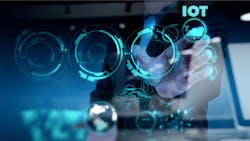The Internet of Things (IoT) has made its way into just about every industry, including fluid power. IoT essentially enables communication between physical objects through the integration of sensors, software and processing capabilities to allow the exchange of information between devices.
“We are seeing companies who are putting out tens of thousands and hundreds of thousands of deployable sensor systems when building hydraulic machinery,” says Jon Prescott, co-founder and CEO of Scante. These sensors are being integrated into individual hydraulic components as well as systems, bringing IoT capabilities to several parts of a machine.
The cost and capabilities of sensors and other necessary technologies have come down over the years, making it more feasible to implement IoT in various applications. Prescott says the ability to now use so many sensors has been a game-changer for mobile hydraulic applications. More information can be collected at faster speeds, enabling manufacturers and their customers to get better data on the performance of machines and components.
Improvements in oil quality sensors is an area in which the hydraulics industry is benefiting, as well, says Prescott. Frequent oil sampling is difficult and an issue the industry has been struggling with for years. “The new areas of oil quality sensing using electrochemistry [and other techniques] are absolute game changers for hydraulic system reliability,” he says.
The cloud-based calculations, dissemination of data and the analytics possible with these new sensors and other IoT-related technologies will greatly benefit manufacturers, particularly smaller ones who don’t have the expertise required for conducting oil analysis.
“I think one of the leading pieces I find interesting is how IoT can be used to do just-in-time repairs,” says Chad Repp, business development manager at HED Inc. This can greatly benefit a manufacturer’s end-use customers by reducing their downtime, as repairs can be made before a critical failure instead of after.
While there has been some implementation of this capability, Repp says it has not yet reached its full market potential. But as IoT adoption grows and users leverage its real-time, day-to-day information capabilities, just-in-time repairs will become more common which will help to improve the efficiency and productivity of many operations.
When looking to implement IoT, it is important to ensure the partners chosen—from the gateway manufacturers to the cloud providers to the solution itself—are the right ones to meet the application requirements. It is important to have the right partners because it is not a single component that is being developed but a solution which evolves and grows over the years to continue serving the customer’s needs.
“The way we look at IoT is it is just another feature inside the tech stack,” says Adam Livesay, co-founder and CRO of Elevāt. “Five or six years ago, IoT was looked at as being the thing that provided the solution to every problem out there, and you could solve everything.”
However, that mindset has shifted. “Now, the way we look at it is you are really trying to focus on the business case, and the problems or goals that customer [has], and then work your way back to where you are talking about cloud, mobile, machine learning, edge and IoT all combined. And that's how we approach it,” he says. “[IoT] is not really that fancy buzzword anymore as much as it is part of the overall solution.”
Repp agrees that IoT and technology in general helps to solve problems. “IoT is more of an enabler of solving problems in the world,” he says. “IoT is a way to help with digital transformation and solving the problems that are part of that strategy, and the value proposition behind it all.”
About the Author
Sara Jensen
Executive Editor, Power & Motion
Sara Jensen is executive editor of Power & Motion, directing expanded coverage into the modern fluid power space, as well as mechatronic and smart technologies. She has over 15 years of publishing experience. Prior to Power & Motion she spent 11 years with a trade publication for engineers of heavy-duty equipment, the last 3 of which were as the editor and brand lead. Over the course of her time in the B2B industry, Sara has gained an extensive knowledge of various heavy-duty equipment industries — including construction, agriculture, mining and on-road trucks —along with the systems and market trends which impact them such as fluid power and electronic motion control technologies.
You can follow Sara and Power & Motion via the following social media handles:
X (formerly Twitter): @TechnlgyEditor and @PowerMotionTech
LinkedIn: @SaraJensen and @Power&Motion
Facebook: @PowerMotionTech

Leaders relevant to this article:

